Bobbin Tool Friction Stir Welding of Aluminum Using Different Tool Pin Geometries: Mathematical Models for the Heat Generation
Abstract
1. Introduction
2. Methodology and Procedures
3. General Equations of Heat Generation during BT-FSW
4. Heat Generation for BT-FSW with Cylindrical Pin
4.1. Heat Generation by BT-FSW at Shoulders
4.2. Heat Generation by BT-FSW at Cylindrical Pin Surface
5. Heat Generation Model for BT-FSW with Square (Sq) Pin
5.1. Heat Generation in BT-FSW from Concave Shoulders
5.2. Heat Generation in BT-FSW from Sq Pin Surface
6. Heat Generation for BT-FSW with Triangle (Tr) Pin
6.1. Heat Generation from BT-FSW from Concave shoulder
6.2. Heat Generation in BT-FSW from Tr Pin Surface
7. Results and Discussion
7.1. Model Results and Discussion
7.2. Model Validation
8. Conclusions
- The developed models are very useful and valid for the predication of the heat generation and temperatures during BT-FSW of aluminum alloys. BT-FSW is one of the important FSW variants that has attractive advantages for industrial applications.
- The developed models considered the most common tool pin geometries and also validated and examined at a wide range of travel speeds for welding as an important parameter in controlling the weld quality and properties.
- The amount of heat generated during BT-FSW is directly proportional to the tool rotation rate, friction coefficient, welded pate thickness, shoulder radius, shoulder concave angle, and the tool pin surface area at constant shoulder surface areas. Meanwhile, it is inversely proportional to the tool travel speed.
- The BT with square pin resulted in higher heat generation (3451 J/mm at 200 mm/min and 875 J/mm at 1000 mm/min) and consequently higher welding temperatures (384 °C at 200 mm/min and 260 °C at 1000 mm/min) relative to the other two pins. The triangular pin generated the lowest heat generation (2965 J/mm at 200 mm/min and 820 J/mm at 1000 mm/min) and temperatures (380 °C at 200 mm/min and 254 °C at 1000 mm/min). This implies that as the pin surface contribution increases relative to the shoulder surface area, the total heat generated increases and consequently the welding temperature increases.
- The obtained welding temperatures from the models and that measured during BT-FSW are in good agreement at all the investigated welding speeds especially in the case of the square and cylindrical pins, proving the validity of the developed models for the predication of the heat generation as well as the welding temperatures. This will allow proper designing of the BT-FSW parameters and avoiding the conditions that can deteriorate the joint quality and properties.
Author Contributions
Funding
Institutional Review Board Statement
Informed Consent Statement
Data Availability Statement
Conflicts of Interest
Nomenclature
| AA | Aluminium alloys |
| α | Angle of shoulder |
| ω | Angular velocity |
| M | Applied torque |
| dA | Area of the infinitesimal element, mm2 |
| BT | Bobbin tool |
| BT-FSW | Bobbin tool friction stir welding |
| CT-FSW | Conventional tool friction stir welding |
| cy | Cylindrical |
| d | Deformation |
| δ | Extent of slip between the tool and the workpiece |
| Fs | Flat shoulder |
| fr | Friction |
| μ | Friction coefficient |
| τs | Frictional shear stress, Mm2 |
| Qd | Heat generated by deformation |
| Qf | Heat generated by friction |
| Qls | Heat generated by lower shoulder |
| Qp | Heat generated by pin |
| Q2.s | Heat generated by two shoulder |
| Qus | Heat generated by upper shoulder |
| J | Joule |
| lss | Lower shoulder surface |
| Tm | Melting temperature. |
| mm | Millimetre |
| min | Minutes |
| PP | Pin profile |
| Aps | Pin surface area of bobbin tool |
| p | Pressure, GPa |
| Rls | Radius of lower shoulder |
| Rls | Radius of lower shoulder |
| Rp | Radius of pin |
| Rus | Radius of upper shoulder |
| rpm | Revolutions per minute |
| TR | Room temperature. |
| A2s | Shoulders surface areas of bobbin tool |
| Tm | Solidus temperature |
| sq | Square |
| μo | Static friction coefficient |
| φ | The extent of slip between the tool and the workpiece |
| Qt | Total heat generation |
| Ts | Travel speed, mm/min |
| tr | Triangle |
| Us | Upper shoulder |
| Uss | Upper shoulder surface |
| Tw | Welding temperature |
| Tw | Welding temperature |
| σy | Yield stress, MPa |
References
- Threadgill, P.L.; Ahmed, M.M.Z.; Martin, J.P.; Perrett, J.G.; Wynne, B.P. The Use of Bobbin Tools for Friction Stir Welding of Aluminium Alloys. Mater. Sci. Forum 2010, 638–642, 1179–1184. [Google Scholar] [CrossRef]
- Meilinger, A.; Torok, I. The Importance of Friction Stir Welding Tool. Prod. Process. Syst. 2013, 6, 10. [Google Scholar]
- Bastier, A.; Maitournam, M.H.; Dang Van, K.; Roger, F. Steady State Thermomechanical Modelling of Friction Stir Welding. Sci. Technol. Weld. Join. 2006, 11, 278–288. [Google Scholar] [CrossRef]
- Heurtier, P.; Jones, M.J.J.; Desrayaud, C.; Driver, J.H.H.; Montheillet, F.; Allehaux, D. Mechanical and Thermal Modelling of Friction Stir Welding. J. Mater. Process. Technol. 2006, 171, 348–357. [Google Scholar] [CrossRef]
- Essa, A.R.S.; Ahmed, M.M.Z.; Mohamed, A.Y.A.; El-Nikhaily, A.E. An Analytical Model of Heat Generation for Eccentric Cylindrical Pin in Friction Stir Welding. J. Mater. Res. Technol. 2016, 5, 234–240. [Google Scholar] [CrossRef]
- Quintana, K.J.; Silveira, J.L.L. Mechanistic Models and Experimental Analysis for the Torque in FSW Considering the Tool Geometry and the Process Velocities. J. Manuf. Process. 2017, 30, 406–417. [Google Scholar] [CrossRef]
- Stringham, B.J.; Nelson, T.W.; Sorensen, C.D. Non-Dimensional Modeling of the Effects of Weld Parameters on Peak Temperature and Cooling Rate in Friction Stir Welding. J. Mater. Process. Technol. 2018, 255, 816–830. [Google Scholar] [CrossRef]
- Durdanović, M.B.; Mijajlović, M.M.; Milčić, D.S.; Stamenković, D.S. Heat Generation during Friction Stir Welding Process. Tribol. Ind. 2009, 31, 8–14. [Google Scholar]
- Buglioni, L.; Tufaro, L.N.; Svoboda, H.G. Thermal Cycles and Residual Stresses in FSW of Aluminum Alloys: Experimental Measurements and Numerical Models. Procedia Mater. Sci. 2015, 9, 87–96. [Google Scholar] [CrossRef]
- Nandan, R.; Roy, G.G.; Lienert, T.J.; Debroy, T. Three-Dimensional Heat and Material Flow during Friction Stir Welding of Mild Steel. Acta Mater. 2007, 55, 883–895. [Google Scholar] [CrossRef]
- Hilgert, J.; Schmidt, H.N.B.; Santos, J.F.; Huber, N. Thermal Models for Bobbin Tool Friction Stir Welding. J. Mater. Process. Tech. 2011, 211, 197–204. [Google Scholar] [CrossRef]
- Mehta, M.; Reddy, G.M.; Rao, A.V.; De, A. Numerical Modeling of Friction Stir Welding Using the Tools with Polygonal Pins. Def. Technol. 2015, 11, 229–236. [Google Scholar] [CrossRef]
- Mehta, K.P.; Badheka, V.J. Effects of Tool Pin Design on Formation of Defects in Dissimilar Friction Stir Welding. Procedia Technol. 2016, 23, 513–518. [Google Scholar] [CrossRef]
- Colligan, K.J.; Mishra, R.S. A Conceptual Model for the Process Variables Related to Heat Generation in Friction Stir Welding of Aluminum. Scr. Mater. 2008, 58, 327–331. [Google Scholar] [CrossRef]
- Alves, E.P.; Neto, F.P.; An, C.Y. Welding of AA1050 Aluminum with AISI 304 Stainless Steel by Rotary Friction Welding Process. J. Aerosp.Technol. Manag. São José dos Campos 2010, 2, 301–306. [Google Scholar] [CrossRef]
- Mhedhbi, M.; Khlif, M.; Bradai, C. Investigations of Microstructural and Mechanical Properties Evolution of AA1050 Alloy Sheets Deformed by Cold-Rolling Process and Heat Treatment Annealing. J. Mater. Environ. Sci. 2017, 8, 2967–2974. [Google Scholar]
- Msomi, V.; Mbana, N. Mechanical Properties of Friction Stir Welded AA1050-H14 and AA5083-H111 Joint: Sampling Aspect. Metals (Basel) 2020, 10, 214. [Google Scholar] [CrossRef]
- Silva, A.A.M.; Aldanondo, E.; Alvarez, P.; Arruti, E.; Echeverría, A. Friction Stir Spot Welding of AA 1050 Al Alloy and Hot Stamped Boron Steel (22MnB5). Sci. Technol. Weld. Join. 2010, 15, 682. [Google Scholar] [CrossRef]
- Mishra, R.S. Friction Stir Welding and Processing; Springer International Publishing Switzerland: Cham, Switzerland, 2014; ISBN 978-3-319-07042-1. [Google Scholar]
- Mishra, R.S. Friction Stir Welding and Processing; ASM International: Novelty, OH, USA, 2007; ISBN 978-0-87170-840-3. [Google Scholar]
- Habba, M.I.A.; Ahmed, M.M.Z.; Seleman, M.M.E.; El-nikhaily, A. An Analytical Model of Heat Generation for Friction Stir Welding Using Bobbin Tool Design General Equations of Heat Generation in BT-FSW Heat Generation for BT-FSW With. J. Pet. Min. Eng. 2018, 20, 1–5. [Google Scholar]
- Khairuddin, J.T. Development of Multi Component Loads, Torque and Temperature Measurement Device for Friction Stir Welding Process. Ph.D. Thesis, Universiti Sains Malaysia, Gelugor, Malaysia, 2013. [Google Scholar] [CrossRef]
- Schmidt, H.; Hattel, J.; Wert, J. An Analytical Model for the Heat Generation in Friction Stir Welding. Model. Simul. Mater. Sci. Eng. 2004, 12, 143–157. [Google Scholar] [CrossRef]
- Hamilton, C.; Dymek, S.; Sommers, A. A Thermal Model of Friction Stir Welding in Aluminum Alloys. Int. J. Mach. Tools Manuf. 2008, 48, 1120–1130. [Google Scholar] [CrossRef]
- Waheed, M.A.; Jaiyesimi, L.O.; Ismail, S.O.; Dairo, O.U. Analytical Investigations of the Effects of Tool Pin Profile and Process Parameters on the Peak Temperature in Friction Stir Welding. J. Appl. Comput. Mech. 2017, 3, 114–124. [Google Scholar] [CrossRef]
- El-Tayeb, N.S.M.; Low, K.O.; Brevern, P.V. On the Surface and Tribological Characteristics of Burnished Cylindrical Al-6061. Tribol. Int. 2009, 42, 320–326. [Google Scholar] [CrossRef]
- Hamilton, C.; Dymek, S.; Pietras, A. Numerical simulations for bobbin tool friction stir welding of aluminum 6082-T6. Arch. Metall. Mater. 2018, 63, 1115–1123. [Google Scholar] [CrossRef]
- Entringer, J.; Reimann, M.; Norman, A.; Jorge, F. Influence of Cu/Li Ratio on the Microstructure Evolution of Bobbin-Tool Friction Stir Welded Al–Cu–Li Alloys. Integr. Med. Res. 2019, 8, 2031–2040. [Google Scholar] [CrossRef]
- Ahmed, M.M.Z.; Wynne, B.P.; Rainforth, W.M.; Addison, A.; Martin, J.P.; Threadgill, P.L. Effect of Tool Geometry and Heat Input on the Hardness, Grain Structure, and Crystallographic Texture of Thick-Section Friction Stir-Welded Aluminium. Metall. Mater. Trans. A Phys. Metall. Mater. Sci. 2019, 50, 271–284. [Google Scholar] [CrossRef]
- Ahmed, M.M.Z.; Wynne, B.P.; El-Sayed Seleman, M.M.; Rainforth, W.M. A Comparison of Crystallographic Texture and Grain Structure Development in Aluminum Generated by Friction Stir Welding and High Strain Torsion. Mater. Des. 2016, 103, 259–267. [Google Scholar] [CrossRef]
- Ahmed, M.M.Z.; Wynne, B.P.; Martin, J.P. Effect of Friction Stir Welding Speed on Mechanical Properties and Microstructure of Nickel Based Super Alloy Inconel 718. Sci. Technol. Weld. Join. 2013, 18, 680–687. [Google Scholar] [CrossRef]
- Ahmed, M.M.Z.; Wynne, B.P.; Rainforth, W.M.; Threadgill, P.L. Quantifying Crystallographic Texture in the Probe-Dominated Region of Thick-Section Friction-Stir-Welded Aluminium. Scr. Mater. 2008, 59, 507–510. [Google Scholar] [CrossRef]
- Ahmed, M.M.Z.; Ataya, S.; El-Sayed Seleman, M.M.; Ammar, H.R.; Ahmed, E. Friction Stir Welding of Similar and Dissimilar AA7075 and AA5083. J. Mater. Process. Technol. 2017, 242, 77–91. [Google Scholar] [CrossRef]
- Ahmed, M.M.Z.; Wynne, B.P.; Rainforth, W.M.; Threadgill, P.L. Microstructure, Crystallographic Texture and Mechanical Properties of Friction Stir Welded AA2017A. Mater. Charact. 2012, 64, 107–117. [Google Scholar] [CrossRef]
- Ahmed, M.M.Z.; Wynne, B.P.; Rainforth, W.M.; Threadgill, P.L. Through-Thickness Crystallographic Texture of Stationary Shoulder Friction Stir Welded Aluminium. Scr. Mater. 2011, 64, 45–48. [Google Scholar] [CrossRef]
- Zayed, E.M.; El-Tayeb, N.S.M.; Ahmed, M.M.Z.; Rashad, R.M. Development and Characterization of AA5083 Reinforced with SiC and Al2O3 Particles by Friction Stir Processing; Springer: Cham, Switzerland, 2019; Volume 92. [Google Scholar]
- Refat, M.; Elashery, A.; Toschi, S.; Ahmed, M.M.Z.; Morri, A.; El-Mahallawi, I.; Ceschini, L. Microstructure, Hardness and Impact Toughness of Heat-Treated Nanodispersed Surface and Friction Stir-Processed Aluminum Alloy AA7075. J. Mater. Eng. Perform. 2016, 25, 5087–5101. [Google Scholar] [CrossRef]
- Mohamed, M.; Ahmed, Z.; Ataya, S.; Seleman, M.M.E.; Allam, T. Grain Structure, Crystallographic Texture, and Hardening Behavior of Dissimilar Friction Stir Welded AA5083-O And. Metals (Basel) 2021, 11, 181. [Google Scholar]
- Ahmed, M.M.Z.; Seleman, M.M.E.; Zidan, Z.A.; Ramadan, R.M.; Ataya, S.; Alsaleh, N.A. Microstructure and Mechanical Properties of Dissimilar Friction Stir Welded AA2024-T4/AA7075-T6 T-Butt Joints. Metals (Basel) 2021, 11, 128. [Google Scholar] [CrossRef]
- Ahmed, M.M.Z.; Barakat, W.S.; Mohamed, A.Y.A.; Alsaleh, N.A. The Development of WC-Based Composite Tools for Friction Stir Welding of High-Softening-Temperature Materials. Metals (Basel) 2021, 11, 285. [Google Scholar] [CrossRef]
- Ahmed, M.M.Z.; Ataya, S.; Seleman, M.M.E.; Mahdy, A.M.A.; Alsaleh, N.A.; Ahmed, E. Heat Input and Mechanical Properties Investigation of Friction Stir Welded AA5083/AA5754 and AA5083/AA7020. Metals (Basel) 2021, 11, 68. [Google Scholar] [CrossRef]
- El Rayes, M.M.; Soliman, M.S.; Abbas, A.T.; Pimenov, D.Y.; Erdakov, I.N.; Abdel-mawla, M.M. Effect of Feed Rate in FSW on the Mechanical and Microstructural Properties of AA5754 Joints. Adv. Mater. Sci. Eng. 2019, 2019, 4156176. [Google Scholar] [CrossRef]
- Mehta, M.; De, A.; DebRoy, T. Material Adhesion and Stresses on Friction Stir Welding Tool Pins. Sci. Technol. Weld. Join. 2014, 19, 534–540. [Google Scholar] [CrossRef]


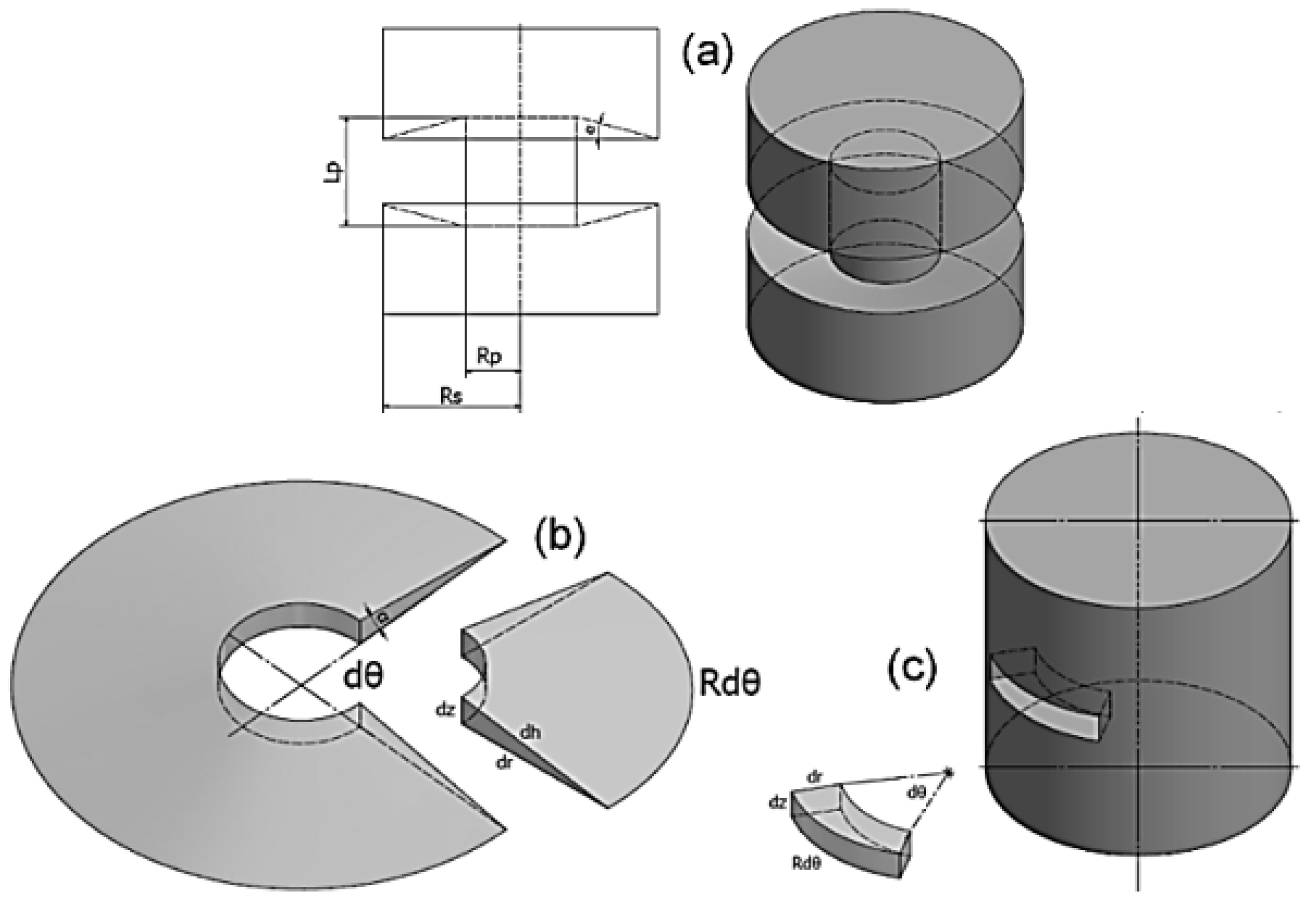
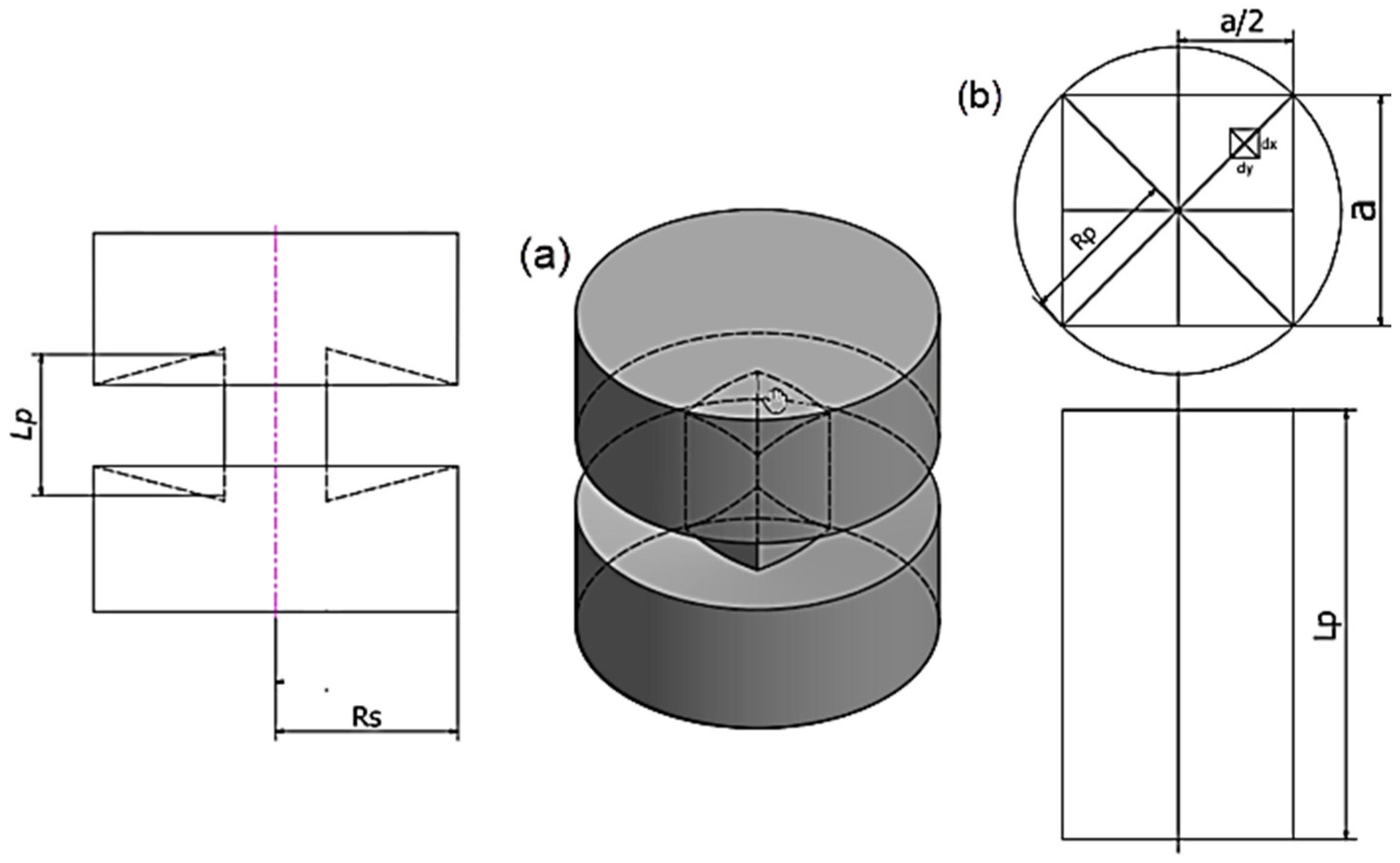
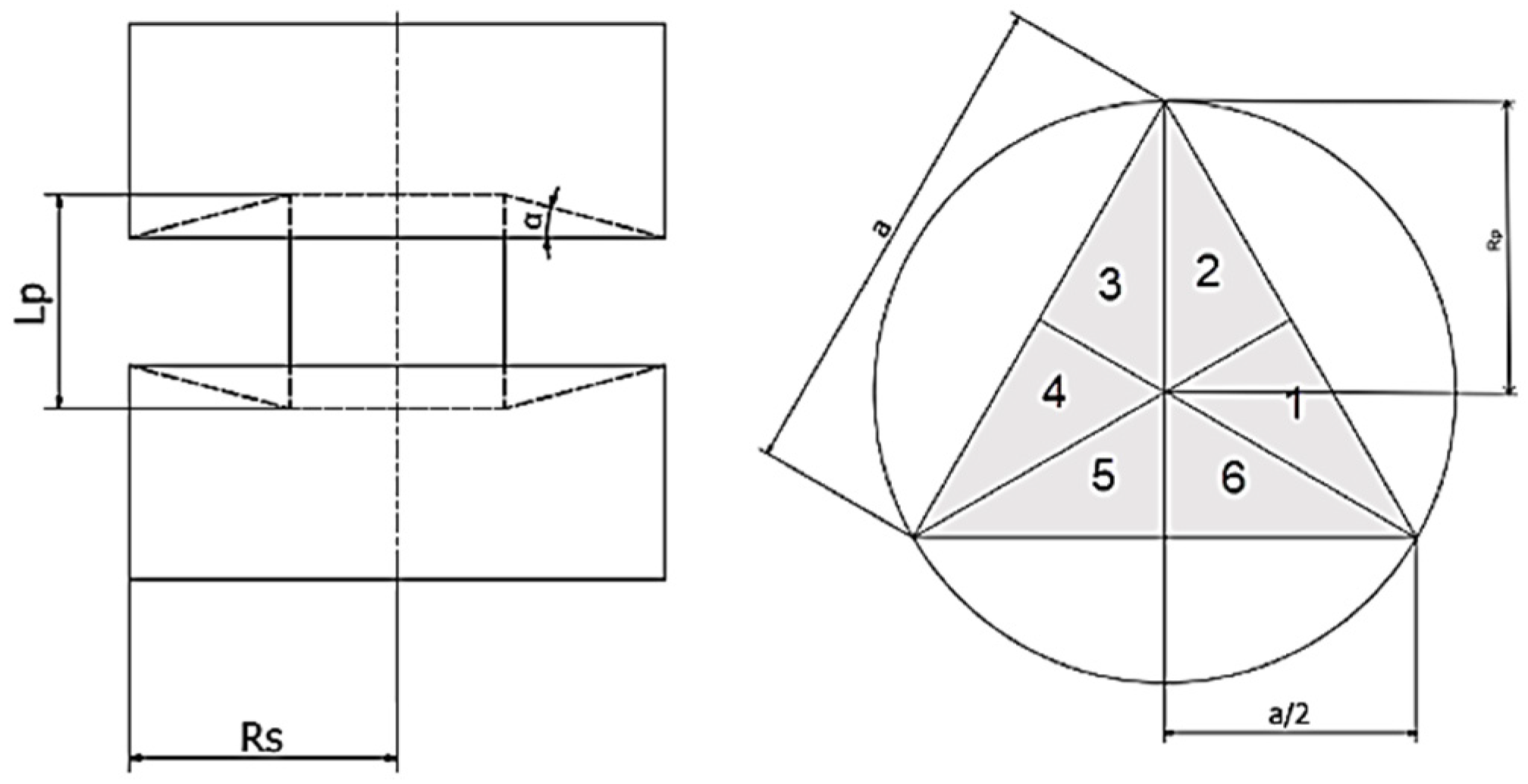

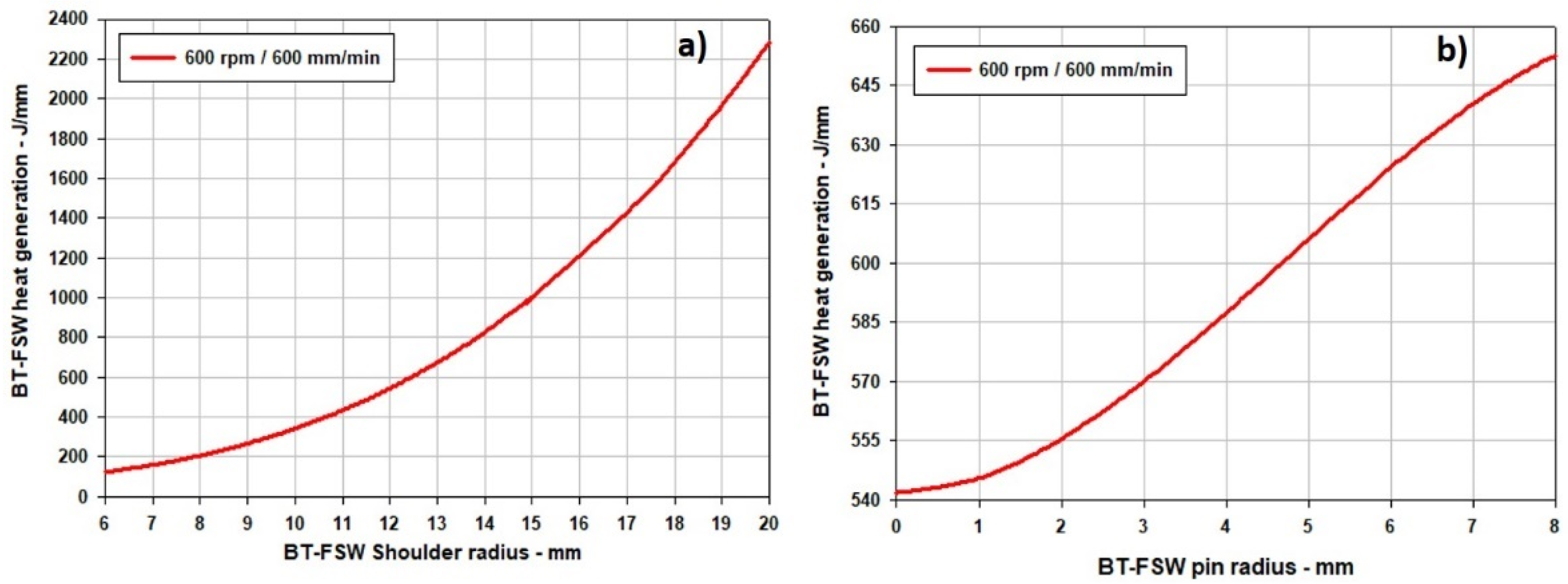

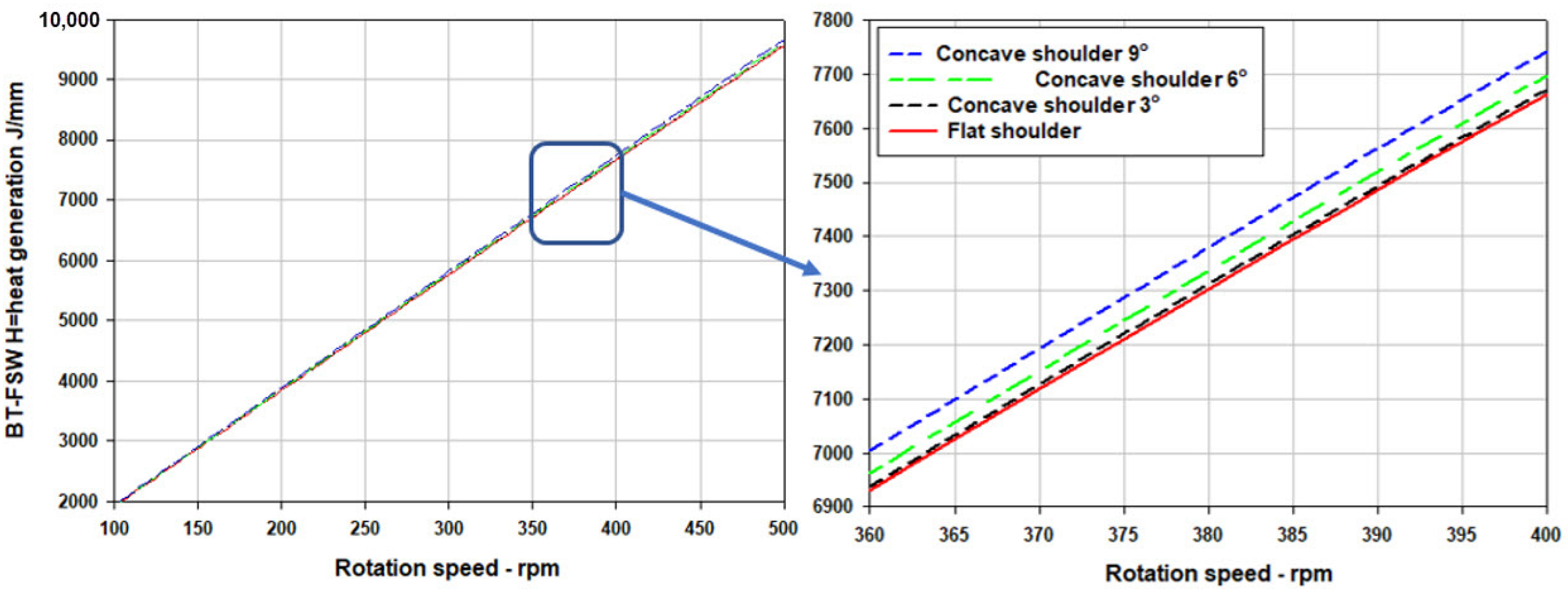


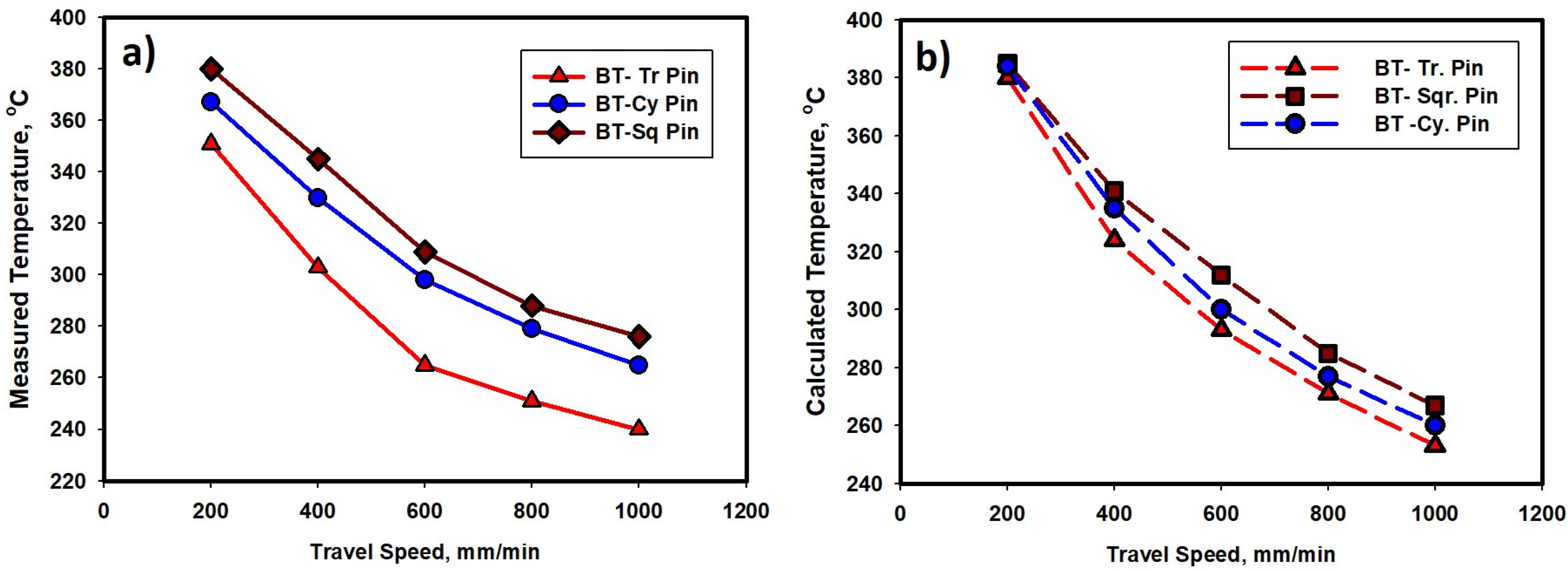
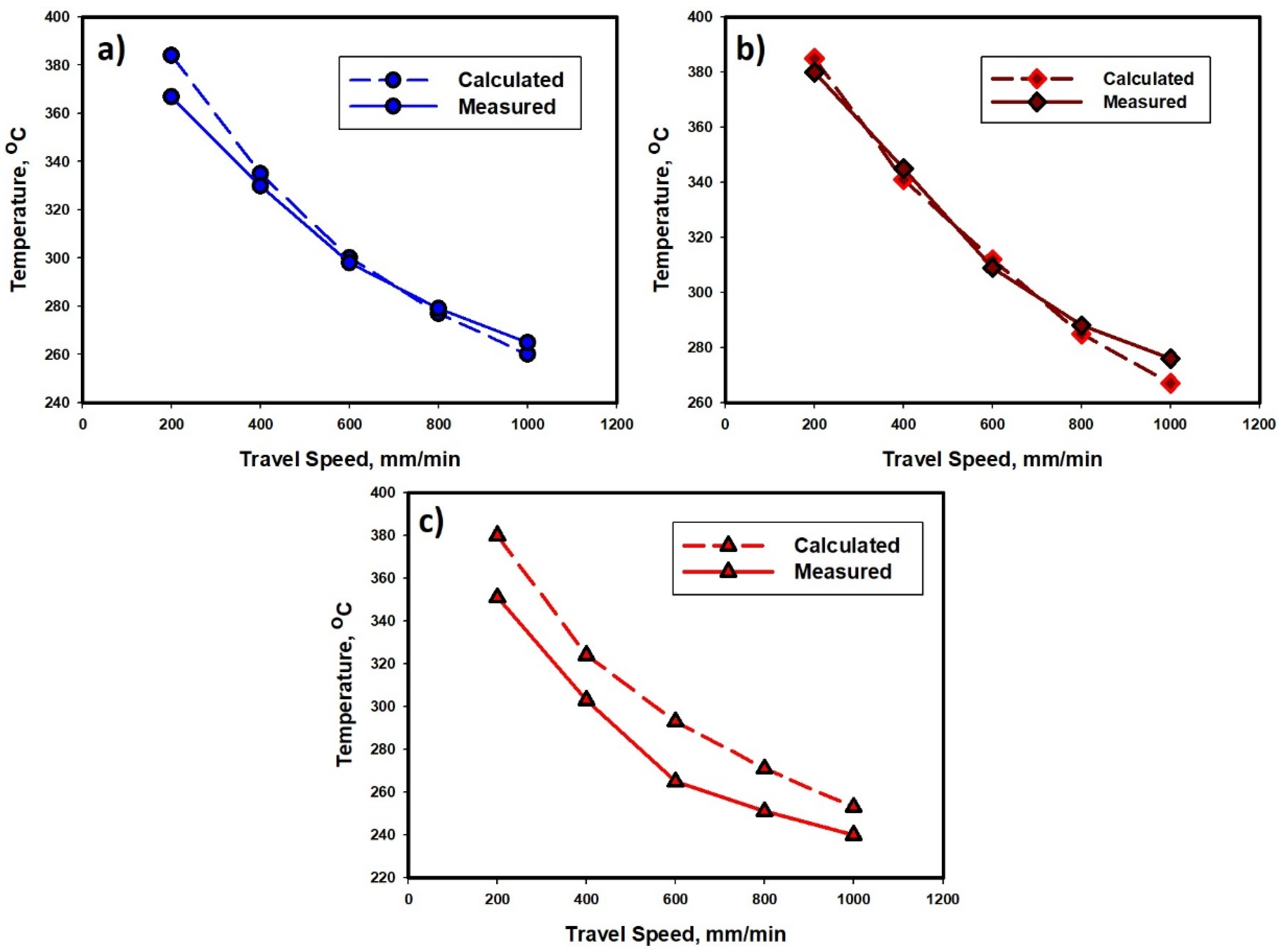
| BT-FSW Tool Description | |
|---|---|
| Upper and lower shoulder | 25 mm diameter |
| Shoulder surface | Concave (≈6°) and cavities |
| Pin dimensions | Cylindrical—10 mm Dia. |
| Square pin with inside circle diameter 10 mm | |
| Triangle pin with inside circle diameter 10 mm | |
| Pin profile “PP” | Smooth |
| Shoulder gap | 9.5 mm |
| Elements in wt. % | ||||||
|---|---|---|---|---|---|---|
| Si | Fe | Cu | Mg | Zn | Ti | Al |
| 0.07 | 0.26 | <0.001 | <0.001 | <0.002 | <0.007 | Bal. |
| Yield strength, MPa | Tensile strength, MPa | Hardness, HV | ||||
| 60 | 100 | 30 | ||||
| Pin Type. | Aps/A2ss | BT-Shoulders | BT-Pin | BT | Tw Model | Measured | ||
|---|---|---|---|---|---|---|---|---|
| Cylindrical Pin | 0.19 | 200 | 0.0466 | 2694 | 524 | 3218 | 384 | 367 |
| 400 | 0.0527 | 1521 | 296 | 1817 | 335 | 330 | ||
| 600 | 0.0580 | 1117 | 217 | 1334 | 300 | 298 | ||
| 800 | 0.0611 | 883 | 171 | 1054 | 277 | 279 | ||
| 1000 | 0.0634 | 773 | 142 | 875 | 260 | 265 | ||
| Square Pin | 0.28 | 200 | 0.0493 | 2702 | 749 | 3451 | 385 | 380 |
| 400 | 0.0553 | 1513 | 419 | 1932 | 341 | 345 | ||
| 600 | 0.0634 | 1158 | 320 | 1478 | 312 | 309 | ||
| 800 | 0.0658 | 900 | 250 | 1150 | 285 | 288 | ||
| 1000 | 0.0676 | 740 | 205 | 945 | 267 | 276 | ||
| Triangle Pin | 0.12 | 200 | 0.0445 | 2637 | 328 | 2965 | 380 | 351 |
| 400 | 0.0502 | 1485 | 185 | 1670 | 325 | 303 | ||
| 600 | 0.0562 | 1109 | 138 | 1247 | 293 | 265 | ||
| 800 | 0.0597 | 885 | 109 | 994 | 271 | 251 | ||
| 1000 | 0.0616 | 729 | 91 | 820 | 254 | 240 |
Publisher’s Note: MDPI stays neutral with regard to jurisdictional claims in published maps and institutional affiliations. |
© 2021 by the authors. Licensee MDPI, Basel, Switzerland. This article is an open access article distributed under the terms and conditions of the Creative Commons Attribution (CC BY) license (http://creativecommons.org/licenses/by/4.0/).
Share and Cite
Ahmed, M.M.Z.; I. A. Habba, M.; Jouini, N.; Alzahrani, B.; Seleman, M.M.E.-S.; El-Nikhaily, A. Bobbin Tool Friction Stir Welding of Aluminum Using Different Tool Pin Geometries: Mathematical Models for the Heat Generation. Metals 2021, 11, 438. https://doi.org/10.3390/met11030438
Ahmed MMZ, I. A. Habba M, Jouini N, Alzahrani B, Seleman MME-S, El-Nikhaily A. Bobbin Tool Friction Stir Welding of Aluminum Using Different Tool Pin Geometries: Mathematical Models for the Heat Generation. Metals. 2021; 11(3):438. https://doi.org/10.3390/met11030438
Chicago/Turabian StyleAhmed, Mohamed M. Z., Mohamed I. A. Habba, Nabil Jouini, Bandar Alzahrani, Mohamed M. El-Sayed Seleman, and Ahmed El-Nikhaily. 2021. "Bobbin Tool Friction Stir Welding of Aluminum Using Different Tool Pin Geometries: Mathematical Models for the Heat Generation" Metals 11, no. 3: 438. https://doi.org/10.3390/met11030438
APA StyleAhmed, M. M. Z., I. A. Habba, M., Jouini, N., Alzahrani, B., Seleman, M. M. E.-S., & El-Nikhaily, A. (2021). Bobbin Tool Friction Stir Welding of Aluminum Using Different Tool Pin Geometries: Mathematical Models for the Heat Generation. Metals, 11(3), 438. https://doi.org/10.3390/met11030438









